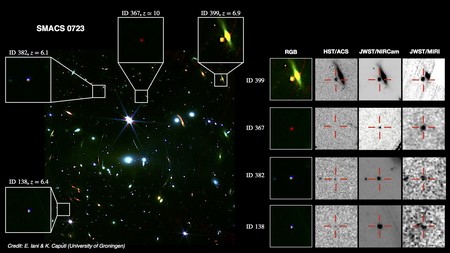Sterrenkundigen zien nu ook infraroodlicht aangaan in jong heelal
Uit de analyse van de allereerste foto van de James Webb-ruimtetelescoop blijkt dat het in Nederland ontwikkelde MIRI-instrument nog beter werkt dan gedacht. Groningse onderzoekers tonen aan dat de infraroodtelescoop details laat zien van sterrenstelsels uit de tijd dat het heelal slechts ongeveer 1 miljard jaar oud was. Deze periode is belangrijk voor astronomen omdat toen de eerste sterrenstelsels werden gevormd. De analyse verschijnt binnenkort in The Astrophysical Journal.
De afgelopen twintig jaar moesten onderzoekers het doen met infraroodbeelden van Spitzer. Deze telescoop kon op lange golflengten slechts terugkijken tot ongeveer 2 à 3 miljard jaar na de oerknal. ‘Je zou misschien denken het miljard jaar eraf van Webb niet zo veel uitmaakt’, zegt onderzoeksleider Edoardo Iani (Rijksuniversiteit Groningen) ‘Maar dan kom je precies in de tijd dat de eerste sterrenstelsels gevormd werden. Dus we zijn heel blij met onze resultaten.’

Jonge sterrenstelsels
Dankzij de infraroodbeelden van de James Webb-ruimtetelescoop zagen de astronomen onder andere sterrenstelsels die nog niet eerder waren ontdekt. Ook konden ze preciezer berekenen hoeveel sterren aanwezig waren in heel jonge, verre sterrenstelsels. De reden dat eerdere schattingen met ruimtetelescoop Hubble onnauwkeurig waren, komt doordat die een groot deel van het oorspronkelijke zichtbare licht niet opvangt omdat het is uitgerekt vanwege de uitdijing van het heelal.
Mede-auteur van de analyse, RUG-hoogleraar sterrenkunde Karina Caputi, verwacht dat er binnenkort meer en diepere beelden beschikbaar komen. ‘Misschien kunnen we dan wel een stukje doordringen in de dark ages. Toen we het MIRI-instrument ontwierpen, hadden we stiekem gehoopt dat het zou lukken, maar het lijkt nu ook echt te gaan gebeuren.’
Over MIRI
MIRI is ontwikkeld door de NASA en de ESA samen met een aantal Europese partners. De MIRI-spectrometer kwam tot stand dankzij inspanningen van de Nederlandse Onderzoekschool voor Astronomie (NOVA) en onderzoeksinstituten in het Verenigd Koninkrijk en Duitsland. Het ontwerp en de bouw werden uitgevoerd door de NOVA Optische-Infraroodgroep bij ASTRON in Dwingeloo in samenwerking met enkele andere Nederlandse instituten en universiteiten.
Tekst: NOVA
Referentie: Edoardo Iani, Karina I. Caputi, Pierluigi Rinaldi & Vasily Kokorev: A first look into the nature of JWST/MIRI 7.7 micron sources from SMACS 0723. Geaccepteerd voor publicatie in The Astrophysical Journal en beschikbaar als preprint
Meer nieuws
-
02 december 2025
Student Menna Zahran wint Unilever Research Prize
-
27 november 2025
Vliegtuigen spotten met een radiotelescoop

